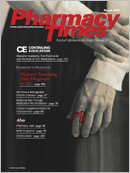Publication
Article
Pharmacy Times
case STUDIES
Author(s):
Case One: EM, a 66-year-old woman,comes to her local pharmacyto refill her prescriptions andin search of a product torelieve her cold symptoms.She approaches the pharmacycounter, where she isgreeted by the pharmacist. Asthe pharmacist is processing the refills, EM explains that sheis miserable due to her cold. She would like to find somerelief, but she feels that she takes enough medications anddoes not want to take any more.
As the pharmacist is asking EM what symptoms she isexperiencing, EM's daughter approaches with 2 herbal productsand asks if either one would work well for EM. The firstproduct contains licorice, and the second contains echinaceaand marshmallow.
The pharmacist reviews EM's medication profile and medicalhistory before making a recommendation. According tothe pharmacy's computerized records, EM's current medicationsinclude:
- Digoxin 0.125 mg daily
- Enalapril 10 mg daily
- Furosemide 20 mg daily
- Glyburide 5 mg twice daily
- Ibuprofen 200 mg as needed
Her medical history is significant for congestive heart failure,hypertension, coronary artery disease, type 2 diabetesmellitus, and osteoarthritis.
She has no known medication allergies, but she does havean allergy to ragweed.
Should the pharmacist recommend either of these productsfor EM's cold symptoms?
Case Two
ST, a 57-year-old male nursewho works for the local pulmonologist,arrives at workone day complaining of weaknessand fatigue. He explainsthat these symptoms haveworsened over several days.He reports feeling out ofbreath when walking aroundthe office but denies having had these difficulties in the past.
ST's medical history is significant for hypertension andbenign prostatic hypertrophy. Three months ago he was hospitalizedwith a ventricular arrhythmia. His current medicationregimen includes:
- Felodipine 5 mg daily
- Tamsulosin 0.4 mg daily
- Amiodarone 400 mg daily
ST denies the use of herbal products or OTC medications.He denies tobacco use but admits to social drinking. His familyhistory is significant for hypertension.
The pulmonologist for whom ST works is concerned aboutST's symptoms and performs a physical examination, alongwith laboratory work. ST's vital signs are reported as follows:blood pressure, 150/95 mm Hg; heart rate, 90 beats/min,temp 98.6°F, and respiratory rate, 20 breaths/min. The exam isunremarkable, with no signs of pulmonary congestion, lowerextremity edema, or signs of infection. The basic metabolicpanel and complete blood count are within normal limits. Theonly lab result found to be outside of normal limits is an elevatederythrocyte sedimentation rate (ESR).
The pulmonologist is concerned that ST's medications maybe causing pulmonary problems. He performs a bronchoscopyto obtain a lung biopsy, which demonstrates diffusealveolar damage and fibrosis.
Should the pulmonologist recommend any changes in ST'smedication regimens?
Dr. Schlesselman is an assistant clinical professor at the University of Connecticut School of Pharmacy.
Click Here For The Answer ----------->
[-]
CASE ONE: Considering EM's current medications and medical history, contraindications exist for both products her daughterselected. The first product contains licorice and may antagonize her cardiac problems. Licorice may increase adverse effects in patients receivingdiuretics or digoxin due to increased potassium loss. Due to sodium and water retention, licorice may also antagonize her antihypertensive therapy.The second product, containing echinacea and marshmallow, may also precipitate problems. Echinacea comes from a plant in the Asteraceae family,the same family as ragweed, to which EM is allergic. Marshmallow may produce additive effects of hypoglycemic agents such as glyburide.
CASE TWO: The pulmonologist's concerns that ST's medications are causing his symptoms are valid. ST is exhibiting signs and symptoms of amiodarone-induced pulmonary fibrosis. These patients typically present with an elevated ESR and dyspnea during the first year of therapy. Treatmentinvolves dosage reduction or discontinuation of amiodarone or initiation of corticosteroid therapy. Symptoms resolve quickly once therapy is altered.
toggle(getObject('exp1048685570_link'), 'exp1048685570');







